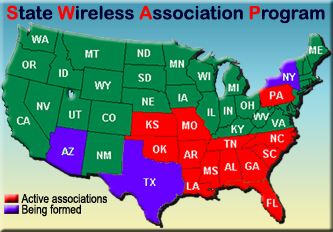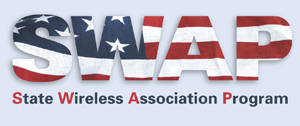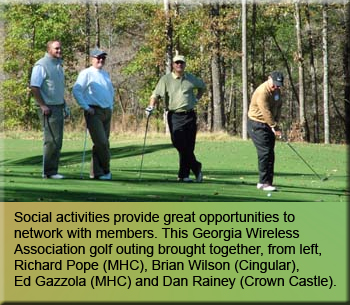|
Banding of carriers, contractors and tower owners allows SWAs to tackle tough industry issues
March 6, 2006 - Students were required to salute the flag at a Washington, DC elementary school last month, but that was not why irate parents demanded that an 80-foot flagpole be removed along with the Sprint antennas it concealed. They were  concerned about possible health dangers. concerned about possible health dangers.
At the same time, some 2,800 miles away in Olympia, WA, city fathers embraced the stars and stripes and approved an ordinance requiring all new cell towers in residential areas to be concealed in flagpoles or other camouflaged structures.
Incongruous events like these are common-place throughout the country every week, but many wireless siting issues are too localized and tax national trade associations' resources to monitor them. However, state wireless associations are quickly filling the need to tackle tough industry issues.
Pennsylvania group to monitor state
The Pennsylvania Wireless Association is the newest entry of state organizations that have been formed to promote positive wireless industry awareness for all sectors of the community. They will hold their organizational kickoff meeting on March 23, in Plymouth Meeting, PA.
Other states with active associations include Alabama, Arkansas-Oklahoma, North and South Carolina, Florida, Georgia, Louisiana-Mississippi, Missouri-Kansas and Tennessee.
The movement to unify tower companies', carriers', contractors' and other industry professionals' voices at the local and regional levels surfaced in Tennessee six years ago when Signal One's Patricia Tant and Crown Castle International's Hunter Stuart saw a need for an organized group that would meet informally to discuss industry concerns.
Long recognized as the driving force behind the formation of new state associations, Tant joined AAT Communications in 2004 following the Missouri-based company's purchase of Signal One's tower assets. As vice president and national sales manager of the nation's largest privately held tower company, she has witnessed the pressing need to have greater resources to counter arguments against tower placement at municipal zoning boards.
Tant and Paul Estes, chief operating officer of AAT Communications, and PCIA-The Wireless Infrastructure Association developed a web site to further promote the advancement of new state wireless associations and PCIA launched SWAP-the State Wireless Association Program (www.swaprogram.net) last May. In addition to providing A Guide For Establishing State Wireless Associations , there are also sample forms that can be used.
Texas, Arizona and New York associations to form
Although PCIA, AAT Communications and other companies provide support to the state wireless organizations, each group is an independent association. New groups are being formed in Texas, Arizona and New York. California and other states have expressed an interest in starting associations.
Last year, Tennessee's association spearheaded one of the first efforts to introduce legislation within their state to place limits on exorbitant fees required to be paid to consultants hired by municipalities for feasibility studies before the studies were even done. According to Stuart, the money was paid into escrow accounts and a minimum had to be maintained in the account, sometimes as high as $8,500, in order for the consultants to do anything. There also were usually no limits placed on how long it would take to perform a study, Stuart said. The proposed legislation limited those fees to not more than $1,500 and tied them directly to the costs of doing the study.
Association quarterly meetings are generally held at various locations within each state. Although zoning concerns are important issues, the associations present speakers on a wide variety of topics from tower site and erector safety to technological advances.
Carolinas group discusses new state safety standards
During January's meeting of The Carolinas Wireless Association, A. John Hoomani, General Counsel of the North Carolina Department of Labor discussed the state's new communications tower, fall protection and non-ionizing radiation standards.
Brian Hurley, president of the North and South Carolina association said that the organization has been well received since its founding last year and has in excess of 200 members.
 Association members are comprised of wireless carriers, tower companies, project management consultants, site acquisition companies, architecture and engineering firms, surveyors, regulatory consultants, general contractors, tower erectors, equipment vendors and suppliers. Association members are comprised of wireless carriers, tower companies, project management consultants, site acquisition companies, architecture and engineering firms, surveyors, regulatory consultants, general contractors, tower erectors, equipment vendors and suppliers.
The associations are valuable for realizing efficiencies such as tower collocation opportunities and creating an industry consensus that is important for lobbying on all levels--be it a municipality considering a tower site location or state lawmakers on proposed regulations.
Golf outings and other social events are held each year and networking opportunities are a key component for the associations' membership growth. Membership is either free or at a minimal fee.
Every day provides a new opportunity to educate zoning authorities and wireless service customers such as a District of Columbia parent who recently informed The Washington Post that "Towers have been proven to emit electromagnet radiation," adding that residents are willing to sue to remove 40 cell sites on school property.
Although a Sprint spokesman said that the technology used on their sites is "a hundred times below FCC safety guidelines," a state wireless association's collective voice might have resonated more effectively.
|